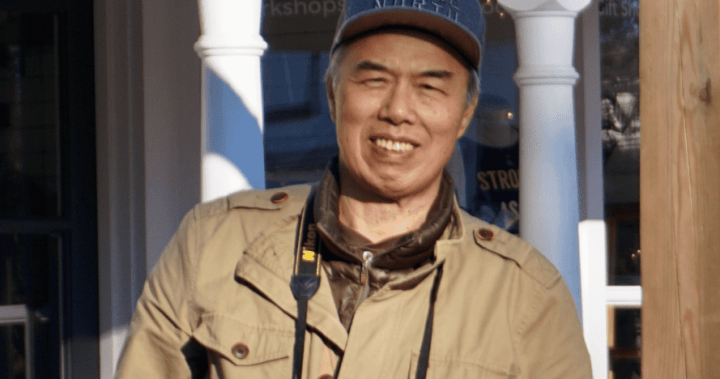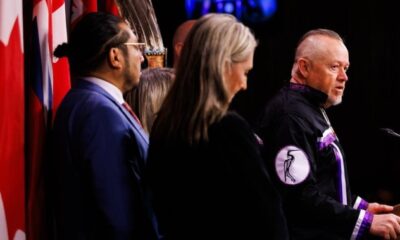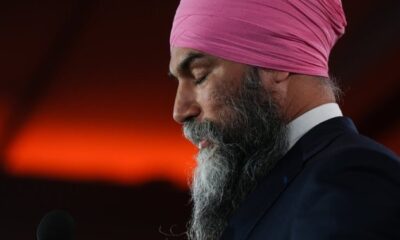Ontario couple whose teenage son died after 8-hour wait in ER calls for law reform

An Ontario family is calling on the provincial government to introduce legislation that would set maximum emergency room wait times for children after their teenage son died following an eight-hour wait for a doctor in a hospital last year.
GJ and Hazel van der Werken, of Burlington, Ont., said their 16-year-old son, Finlay, had a few days of mild illness and was suffering from migraines before his condition began to worsen. Hazel rushed him to Oakville Trafalgar Memorial Hospital on Feb. 7, 2024, she said.
“We go through to the normal emergency department which was filled with a lot of people, just the whole corridor was just full of people in chairs,” Hazel recalled in an interview Thursday. “That was where Finlay was calling out in pain.”
He was triaged quickly, she said, which gave her hope that he’d see at doctor “at any moment.”
“But the ‘any moment’ turned into eight hours and 22 minutes,” Hazel said.
Those eight hours felt like “a constant state of terror” she said, noting the couple later learned that Finlay’s oxygen levels were rapidly deteriorating during the wait. Gradually, Finlay got quieter, she said.
“He basically gave up,” said GJ. “Nobody was helping him.”
When Finlay was finally assessed by a doctor, he was diagnosed with hypoxia and pneumonia caused by sepsis, Hazel said. He was intubated and eventually transferred to SickKids Hospital in Toronto, where he was put on machines to take over the functions of his heart, lungs and kidneys.
“No improvements were made, it just kept going from bad to worse, up to the point where the doctor called us in and said there is no chance of Finlay coming out of this,” said GJ.

Get weekly health news
Receive the latest medical news and health information delivered to you every Sunday.
After Finlay died, the family decided to take legal action. They didn’t want to stay silent about what happened to their son, GJ said.
“Long wait times are normal apparently, and nobody seems to fight this,” said GJ. “Since Finlay can’t voice his concerns, his wishes, his demands anymore, we felt obliged that we have to speak for him and try to do whatever we can to prevent this from happening to other people.”
Earlier this year, the family filed a lawsuit against Halton Healthcare Services, which operates Oakville Trafalgar Memorial Hospital, and several other defendants. Among the allegations is that it had an “inadequate system” to ensure that patients like Finlay were seen by a doctor in an appropriate amount of time, and that it didn’t have enough staff to monitor patients in the emergency department.
A statement from Halton Healthcare expressed condolences to Finlay’s family, but said the organization does not comment on individual patient cases for privacy reasons.
“Like many hospitals, we are seeing more patients presenting with increasingly complex health conditions and co-morbidities, often requiring longer stays and more intensive care,” Cheryl Williams, executive vice-president of clinical operations and chief nursing officer, said in the statement. “This places significant demand on our emergency departments, patient flow, bed availability and the patient experience.”
Halton Healthcare noted it’s “actively advancing” several measures to improve patient care, including new policies to address patient volume and communication.
But Finlay’s story shows a bigger problem in the province’s health-care system, said Hazel. The family has heard stories from others who have lost loved ones due to long hospital wait times, which she said was “not acceptable.”
The family has asked for a coroner’s inquest into Finlay’s death, she said. They’re also calling on the province to enact what they’ve proposed as “Finlay’s Law” — legislation that would set maximum emergency room wait times for children and mandate safe staffing ratios, among other measures.
“For Finley’s triage level, it should have been within 15 minutes that he was seen after being triaged. We are not even close,” said Hazel. “With that many patients, and with patients with that high level of triage it’s not sustainable … worse than not sustainable, it led to Finley’s death.”
Earlier this week, the family launched a petition to call on the Ontario government to pass their proposed law, which would also include independent reviews of pediatric deaths in emergency rooms and better funding for pediatric emergency care.
“Children are not small adults; they deteriorate faster, require specialized dosing and equipment, and often cannot advocate for themselves,” the petition reads. “Without enforceable standards, they remain at the greatest risk in a strained system.”
When asked about the family’s proposed law, the provincial health ministry called Finlay’s case “deeply tragic and unacceptable.”
“The Ministry of Health expects every hospital to uphold the highest standard of patient care and to comply with requirements under the Public Hospitals Act relating to the response and review of critical incidents to ensure they never happen again,” it said in a statement. “We also expect hospitals to disclose the findings from this review with to the impacted patients, or their family.”
For Finlay’s family, much of their frustration comes from the lack of action on hospital wait times, said Hazel, and how their son’s death has sparked their distrust and fear of the health-care system.
“We’re focusing on children right now because that is where our hearts were broken, but it concerns everybody. I’m terrified that any of us get sick and need to go to hospital,” Hazel said.
“I’m exhausted telling our story. But if we don’t do this, does the problem just continue until the next time it happens?”


The Supreme Court of Canada has declined to hear an appeal of a lower-court ruling that upheld a First Nation’s ownership of a stretch of land at a popular Ontario beach after a lengthy dispute.
Canada’s top court has dismissed the appeal request from landowners and the province after a stretch of land along Sauble Beach was returned to Saugeen First Nation in 2023.

Get breaking National news
For news impacting Canada and around the world, sign up for breaking news alerts delivered directly to you when they happen.
This dismissal comes nearly two months after members of Saugeen First Nation changed the iconic “Welcome to Sauble Beach” sign that greeted beach visitors.
The temporary “Welcome to Saugeen Beach” sign was erected to reflect the First Nation’s ownership of the land, with the town’s mayor expressing disappointment that he wasn’t alerted of the change.
The Ontario Court of Appeal upheld last December the decision that 2.2 kilometres of the coastline in South Bruce Peninsula was incorrectly surveyed 170 years ago.
The portion of the land is valuable fishing ground for the First Nation community and was surrendered in 1854 in an agreement with the Crown to give up portions of Bruce Peninsula.
© 2025 The Canadian Press

The majority of post-secondary students in Ontario are stressed about their finances heading into the school year, a new survey found.
The survey from TD Bank, which collected data from post-secondary students across the country, found that 92 per cent of all respondents in Ontario are stressed about their finances.
“The survey was clear that our students are experiencing a lot of stress, which is a bit unique from previous generations because of the multitude of factors that are just hypersensitive at this point, with higher unemployment, higher cost of living, higher tuition,” says Joe Moghaizel, vice-president of everyday advice journey at TD.
The survey found that while 78 per cent of Ontario parents believe their child has experienced financial stress in the past three months, that figure was well below the actual number of 92 per cent.
“What’s interesting is the amount of pressure and stress that they’re currently facing and feeling, and the disconnect between what their parents believe they’re experiencing,” Moghaizel says. “Parents were not aware of the amount of stress that the students are feeling.”
Moghaizel pointed to a number of things leading to this financial pressure, including the high cost of living and high rate of unemployment among young people in a difficult job market, leading to many students to have what he called a volatile income.

Get breaking National news
For news impacting Canada and around the world, sign up for breaking news alerts delivered directly to you when they happen.
The survey also found that Ontario had the highest percentage of students stressed about tuition costs at 35 per cent, compared with an average of 26 per cent in other provinces.
The government of Canada estimates it will take almost 10 years for the average student to pay off their student loans and the total student loan debt in Canada surpassed $23.5 billion in 2022.
“You go back to over two decades ago, when I was in school, the financial pressures that students deal with now are significantly higher because tuition is a lot more expensive and the cost of living is more expensive, and inflation has really taken a bite at students,” Moghaizel says.
Another key takeaway from the survey was that 36 per cent of all respondents found that social spending stressed them out the most.
Moghaizel says the social pressure speaks to the online environment that students find themselves in today, where everything they do is shared online.
“They all feel the pressure to spend and keep up, which, again, it’s not too dissimilar from other age groups and we’re keeping up with the Joneses and just keeping up with the spending habit of your circle creates a bit of pressure,” he says.
Moghaizel says this can leave post-secondary students feeling ill-equipped to manage their finances better.
Despite the concern, Moghaizel hopes this information is not discouraging to students and is an opportunity to start establishing good financial habits early in life.
He said that with societal pressures, it’s good for students to understand their needs versus their wants, and focus on prioritizing the necessities. Moghaizel says that through tracking their spending, students can see where all of their money is going.
“We want to make sure that we’re equipping students with the right understanding of financial knowledge for the products and services,” Moghaizel says.
© 2025 Global News, a division of Corus Entertainment Inc.

A Canadian man has pleaded guilty to illegally photographing classified U.S. defence facilities at the Space Force military base in Cape Canaveral, Fla.
Xiao Guang Pan, 71, of Brampton, Ont., pleaded guilty to three counts of unlawful photographing of military installations without authorization on three separate days in early January.
A U.S. District Court in Florida judge put Pan on probation for 12 months and immediately ordered him deported to Canada by U.S. Immigration and Citizenship Enforcement (ICE) officers under the U.S. Immigration and Nationality Act, citing his violations of American espionage laws.
Pan did not immediately respond to a request for comment.
A U.S. Department of Justice official was unsure about where Pan is in the ICE deportation process.
Pan’s guilty plea and deportation come as anxiety grows among U.S. lawmakers and ordinary Americans about hundreds of unidentified drones flying over sensitive American military bases amid concerns about foreign surveillance and spying.
A copy of Pan’s plea agreement reveals a stark contrast between what Pan said he was doing in Florida in January, when he was stopped by police, versus what U.S. federal agents actually found on his drone, phone and storage devices after seizing them.
On an artist biography page published by the Brampton Arts Organization, Pan stated he was born in China in 1953, immigrated to Canada in 2001 and has lived in Brampton since 2003.
Pan worked as a Best Buy Canada technician for 18 years until retirement in 2022, the biography adds.
Pan entered U.S. via Detroit
Pan entered the U.S. on a tourist visa at the Ambassador’s Bridge in Detroit, Mich., on or about Nov. 2, 2024. The court documents don’t suggest what Pan was doing or where Pan travelled in November and December.
The retiree was charged by summons on Feb. 11 after the National Aeronautics and Space Administration (NASA) detected drone activity near the Space Force Base and called in law enforcement on Jan. 7.
Brevard County Sheriffs responded. They saw Pan operating a DJI Mavic Pro 3 unmanned drone quadcopter from a parking lot in Port Canaveral and learned he’d been in the area for three days.
The local officers then tipped federal law enforcement agencies.
Federal agents caught the Brampton resident using his powerful unmanned drone and a separate camera with telephoto lenses to photograph and video classified military facilities and equipment near the Space Force base on Jan. 5, 6 and 7, without the base commander’s prior authorization as required under U.S. law.

Get breaking National news
For news impacting Canada and around the world, sign up for breaking news alerts delivered directly to you when they happen.
According to a statement of facts found in the plea agreement, which Pan signed and initialled on every page, U.S. federal agents interviewed him twice – no dates were given – and asked the Canadian what he was doing with the drone.
They also warned him: lying to federal agents is a federal crime in the U.S.
“Pan told the agents that he had flown his drone to take pictures of the beauty of nature, the sunrise, and the cruise ship port. He stated that he had not seen any launch pads and that he did not know that he was near a military installation,” the plea deal states.
Pan voluntarily submitted his devices to U.S. agents for a forensic data extraction.
That’s when the investigators found more than sunrises, nature and cruise ship videos.
The data showed Pan had flown his drone nine times and taken 1,919 photographs and videos during his three-day Florida visit, the plea deal states.
Of those 1,919 photos and videos, 243 photographs and 13 videos showed specific images of Space Force base military infrastructure and launch facilities, including fuel and munitions storage facilities, security checkpoints, and a Navy submarine platform, according to the plea agreement.
On Jan. 6, his second day of flying the drone quadcopter, Pan took nine videos and 166 photographs of Space Force installations.
This time, he launched his drone from a location several miles closer to the base; his photographs and videos captured the same military infrastructure as on Jan. 5, but in higher quality and from different angles, according to the plea agreement.
Pan also captured images and videos of mission control infrastructure and fuel and munitions facilities, including a photograph of a Space Launch Complex and payload processing facilities operated by two defence contractors.
On the third day of his drone flying, and before he was encountered by law enforcement, Pan recorded two more videos and took 56 photos.
Day 3 images included security checkpoints
His Day 3 images and videos showed roads, power distribution infrastructure, security checkpoints, mission control infrastructure, national security space launch infrastructure, fuel and munitions storage, and naval infrastructure, the plea agreement states.
After police stopped Pan on Jan. 7, federal agents interviewed him twice.
During those interviews, Pan was warned that lying to agents is a federal crime. He did so anyway, the plea deal suggests.
In addition to telling agents he flew his drone to record nature, sunrises, and cruise ships and didn’t know he was near a military base, Pan said his drone sends alerts and warnings to his handset and he received no alerts or warnings, the plea deal adds.
Investigators recovered flight log data from Pan’s quadcopter. It showed that on all three days he flew, the drone logged several alerts and sent operator messages about altitude and FAA airspace violations.
On Pan’s cell phone, agents also found several screenshots he created, including several Google Maps satellite overviews of Cape Canaveral. One screenshot taken Jan. 7 while Pan was at his drone launch location, prominently displayed the words “Cape Canaveral Space Force Station.”
Pan surrendered his $5,000 quadcopter
Pan was charged in February after a multi-agency probe led by the U.S. Federal Bureau of Investigation, U.S. Homeland Security, and the U.S. Air Force Office of Special Investigations.
Pan surrendered his $5,000 quadcopter, control equipment and storage devices that housed his videos and photos to the U.S. authorities.
He is also banned from returning to the U.S. without prior consent from the Secretary of the Homeland Security department.

-

 Uncategorized3 months ago
Uncategorized3 months agoShop Proud, Eat Proud, Be Proud — Ottawa Canada Day Market This June 28th
-

 3 months ago
3 months agoCanada’s world junior trial saw juries tossed, intense testimony. Here’s a recap
-

 2 months ago
2 months agoRing of Fire road to bring prosperity to First Nation, problems for caribou: report
-

 2 months ago
2 months agoMeasles circulating in northeastern B.C. community, health officials warn
-

 3 months ago
3 months agoAnishinabek Nation chief says he briefed Ontario police on protests against Bill 5
-

 2 months ago
2 months agoFormer major leaguer, Jays doctor Ron Taylor dies
-

 2 months ago
2 months agoJagmeet Singh apologizes for attending Kendrick Lamar concert after Drake calls him out
-

 2 months ago
2 months agoDreaming of a lakeside cottage but can’t afford it? Co-ownership could open that door







